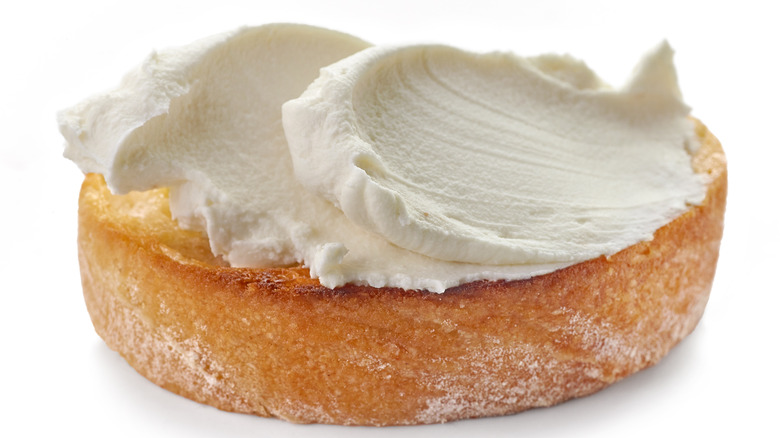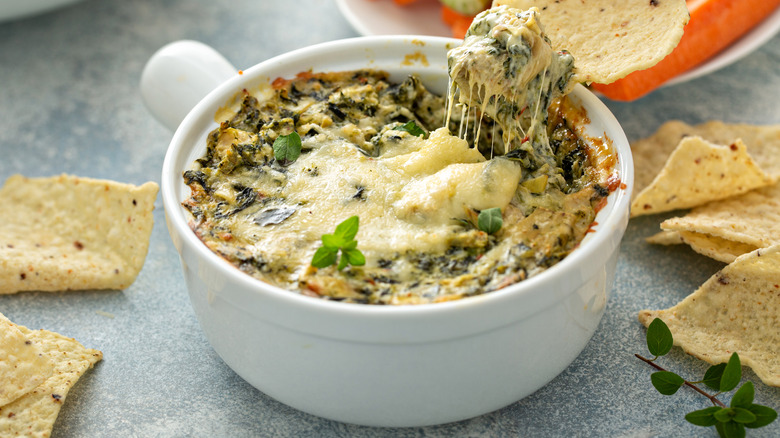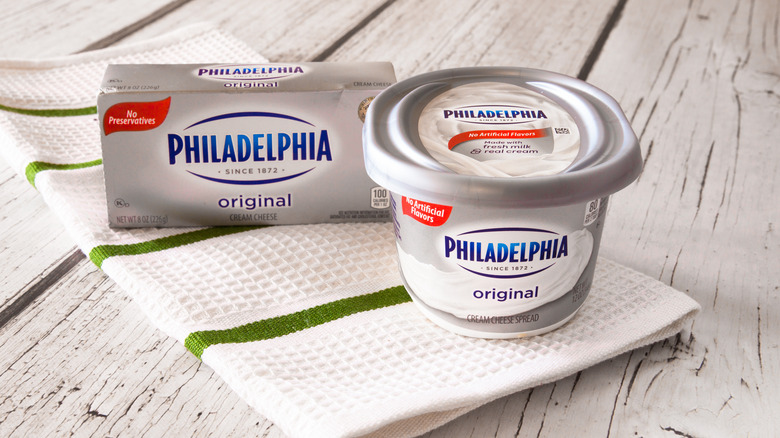What Is Cream Cheese And Is It Actually Cheese?
Imagine: It's breakfast time and you are wandering around your kitchen, figuring out what to make. Then you spot it: a bag of dense, yummy bagels calling your name. Now, what do you put on it? Cream cheese, of course. In 1872, the creamy, tasty classic now known as cream cheese was born, right out of New York City, according to The Spruce Eats.
Over the years, cream cheese has become a classic for breakfast and at other times, as it can be thrown into many desserts, appetizers, and even dinner items like crab rangoon and creamy pasta dishes. There are hundreds of recipes calling for cream cheese online, proving just how popular and diverse this ingredient really is.
The most popular cream cheese today is Philadelphia — not much of a surprise. Being the first brand to come on the market, it is no shock it still reigns supreme. Even with its immense popularity, and regardless of the brand, there are still a lot of unknown and interesting things to unpack in each container of creamy goodness.
What really is cream cheese?
Cream cheese is just as much a cheese as mozzarella, cheddar, and gouda. It's considered official cheese, meeting the standards of the Food and Drug Administration, which requires cream cheese to have at least 33 percent fat and no more than 55 percent moisture.
It is produced with unskimmed cow's milk and it gets its firm, yet creamy texture from lactic acid. (Lactic acid is formed in sour milk, which is used to create cream cheese.) Don't worry, however; there is no sour flavor left in the cream cheese (depending on how long it's been sitting in your fridge, that is).
If you happen to be worried about the product's high fat percentage, there are low-fat and nonfat varieties that pass FDA standards and will still make any homemade cheesecake a staple dessert dish. For that matter, have you ever wondered how cream cheese can go in both a cheesecake and spinach artichoke dip, yet offer two completely different flavors?
How to cook with cream cheese
There are what seems like a-million-and-one ways to cook with cream cheese — one being, not cooked at all. From jalapeño poppers to carrot cake, there are an abundance of choices. If you have some left over in the back of your fridge, in 30 minutes or less you could easily whip up a creamy sauce over noodles or cheesy stuffed chicken breast for dinner.
Cream cheese is incredibly easy to melt, but even easier if left out at room temp for a bit, because most of what you will use cream cheese for is to dip, spread, or mix — the three best ways to indulge. Cream cheese is the end all be all of cooking as the tangy and smooth flavor can turn into all kinds of savory or sweet dishes.
If you are wanting to go for a dessert, cream cheese is great as a frosting or mixed into the batter to add a smooth and moist texture. If you want to bring a dip to a friend's party, you can have a cold or warm contribution with the help of cream cheese. Buffalo chicken dip, bean dip, loaded potato dip, and more can all be created with cream cheese. And for dinner, well, pull out your big skillet, throw in some cream cheese, lemon, garlic, and pepper, and pour that over noodles to have a quick, easy, and delicious weekday meal.
What does cream cheese taste like?
A regular, unflavored package of cream cheese tastes like a tangy, sweet, yet mild spread. If you put the traditional flavor on a flavored bagel (such as an everything or cinnamon raisin) you will get a good balance of sweet and tangy.
The mild flavor is what makes it so easy to use in a huge variety of different dishes. Cream cheese picks up other flavors well and adds to them, instead of overpowering — and the subtle flavor adds more structure when added to savory dishes. A jalapeño popper would not be nearly as good if it weren't for the cream cheese mixing with the heat.
Cream cheese brands also know pretty well that it mixes well, since now you can buy pre-made cream cheese flavors. Some brands, like Philadelphia, also make picking your flavor easy by having categories to choose from, like original, sweet, and savory. Flavors range from garlic and herb to chive and onion to strawberry or blueberry (via Kraft Heinz).
The nutritional value of cream cheese
Cream cheese may be a household favorite, but much like every other cheese, it is best to eat in moderation. Heathline reports that one ounce of regular cream cheese includes 99 calories, 10 grams of fat, two grams of carbs, and no fiber. Granted, there is a good dose of Vitamin A and Riboflavin in every ounce.
Since it is high in fat, limiting how much you eat is important, as it also doesn't provide many good-for-you nutrients. There are healthier options for your spreading desires, such as fat-free or low-fat cream cheeses, but they won't offer the same flavor as the fat-packed original.
Don't fret. There are still some positives of eating cream cheese, and you can focus on them when indulging. In one ounce of cream cheese, there are 87 mg of vitamin A, which is great for your vision (via Healthline). It is also full of antioxidants that help your body fight off cellular damage.




